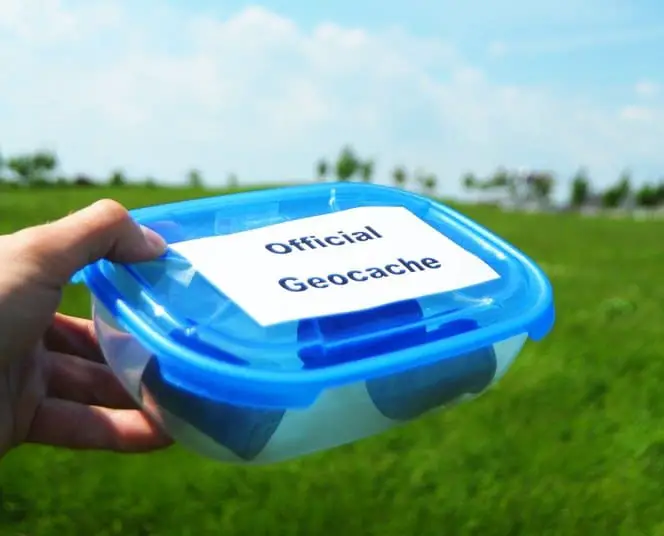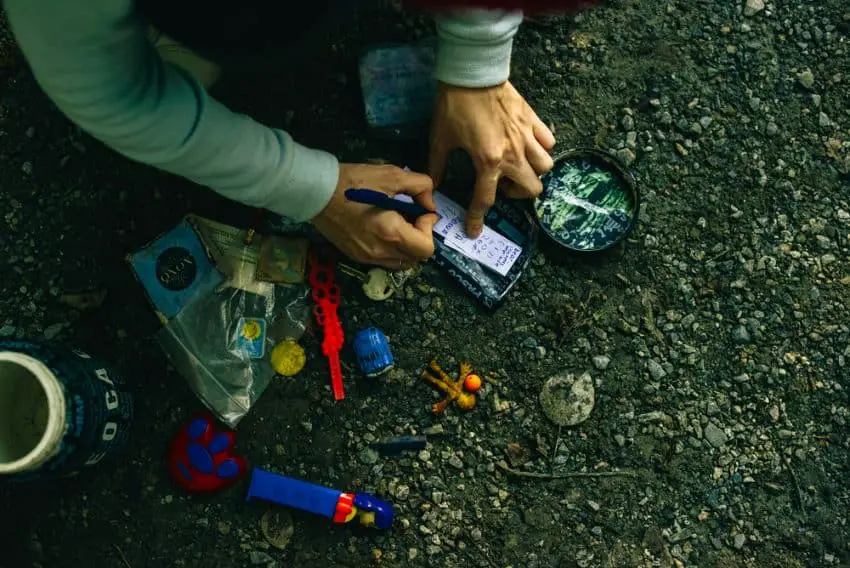
This article will walk you through the right process for getting started geocaching!
I’ve made sure to cover almost all this hobby aspects. By the end of this article you will learn all what it takes to do well at this activity and avoid all the mistakes that most beginners make.
Let’s dive in!
What is Geocaching?
In simple terms, geocaching is a worldwide game of hide and seek. The goal is to find hidden caches that could be everywhere throughout the world.
People unknowingly walk past caches everyday.
Which is part of the fun of the game. Only those in the know are able to find caches. At least, that’s the point of the game.
Caches are found by using your smartphone, or tablet, apps to get GPS coordinates that lead you to where a cache is located. It is up to you to think outside the box and try to find a good hiding spot where someone might hide a cache.
Easier said than done.
People that hide caches are crafty and will do whatever they can to make a cache hidden enough to where an everyday person will not discover it.
Geocaching is made up of a large community of players all around the world. There are plenty of caches hidden by players, and the official app gives you the opportunity to log your finds and join forums with other players.
The game provides an excellent way to explore new cities, or your very own backyard all while getting in some fresh air and always valuable exercise.
Geocaching history – Quick overview!
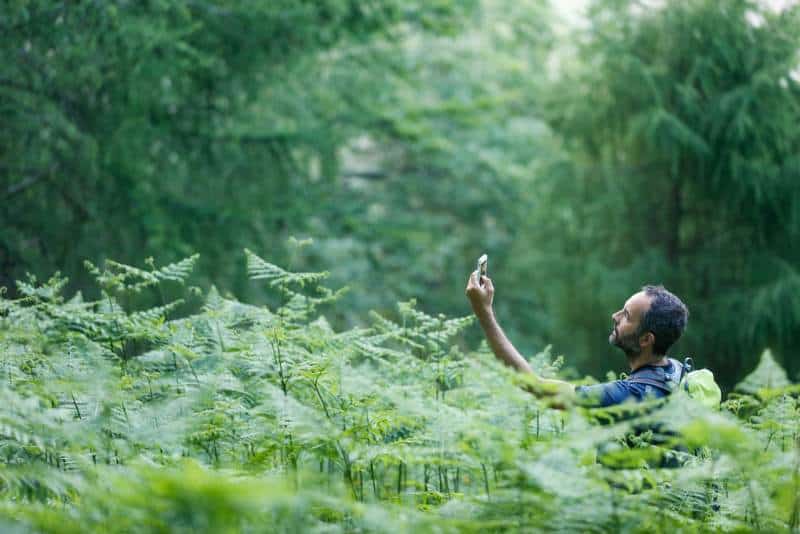
Back in the early 2000s, Dave Ulmer took advantage of the emerging GPS technology that became available to everyone outside of the military. At this point in time, the new technology meant GPS was more accurate and widely available.
Dave wanted to test how accurate GPS was, so he hid a black bucket in the woods near Beavercreek, Oregon. He called this idea the “Great American GPS Stash Hunt” and posted it in an internet GPS users’ group.
It took three days for two users to locate the bucket. They wrote about their experience on the forum and from there it took off.
Not long after, Matt Stum coined the term Geocaching. For two decades the game continues to grow in popularity.
How and Where should I Start?
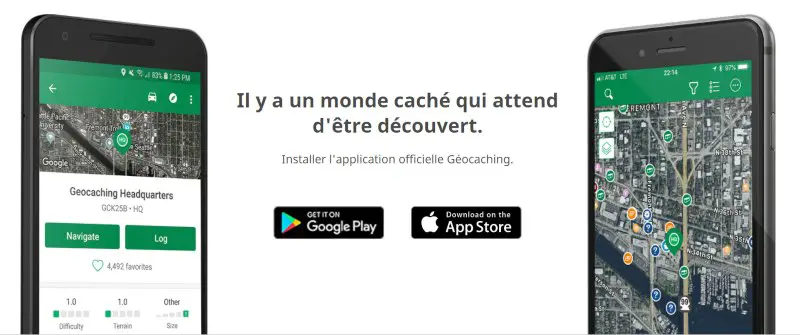
First off, create an account with the official geocache website. It’s simple, and fast. Then you’ll want to download the app and login.
Once you do these two, then you are almost ready to get started. There’s a few things you should take into consideration before you head out for your first cache.
Think about where you want to hunt. Close to home? A little further out? Somewhere you’ve never been?
Staying local, preferably as close to home as possible, is the best option for someone starting out. Luckily, caches have difficulty levels. Go for the easy ones at first. Get a feel for the game.
Public parks are excellent places to start. You are almost guaranteed to find a cache at a park. A cache with a ton of logs will be best to start with. A lot of logs means it is kept up with by the owner, and easier to find than others.
Try to find a few caches to hunt on the app before heading out. In case you have no luck finding the first one, you can move onto the next. That’s part of the fun, exploring the world around you.
These are the rules …
1. Rule number is be safe, but have fun at the same time
Seriously, safety is a major concern when exploring. Snakes, insects, dogs, people are all potential dangers. Be alert, but equally important, have fun.
You are playing a game that gives you a secret those around you don’t know – there’s something hidden and you are the one to find it.
2. If you take something, leave something equal or better
Some caches are large enough to hold small trinkets and things along those lines. My personal favorite to leave behind was small toy skateboards.
I would trade a skateboard for whatever was left behind by another player – examples would be plastic gold coins or erasers.
3. Write in the cache logbook
Every cache has a logbook. You could write your name, or give yourself a gamer name to sign as. It’s part of the game to sign the logbook. This let’s others know you found the cache.
Before you know it, you may become a local celebrity when everyone notices your name popping up on all the caches in town.
4. Log your experience at geocaching.com
This is another rule of the game you must follow. The official app allows you to log your find without having to visit the site.
You’ll want to log your find and describe your experience. Some players like to leave notes about the cache such as the condition of it, whether a logbook was available, or a clue if it was difficult to find for other players.
This important step in finding a cache helps the owners know whether they need to upkeep the cache.
Geocaching terms you should be familiar with!
Every hobby has its own lingo, and Geocaching is no different. You’ll see so many new terms that will at first feel overwhelming.
Don’t worry, you’ll pick up the lingo fast, and before you know it, you won’t sound like a muggle anymore.
Let’s start with muggle …
… A muggle is a non geocacher. The name took heavy inspiration from Harry Potter – a non-magical person. Muggled means a cache that was discovered, dismantled, or removed by an unsuspecting non-player. It happens.
Caches come in all sizes, but the micro is the smallest geocache size. These are tough, and beginner players might want to avoid them at first.
Let’s take a step back and talk about cache attributes. This term reflects all the details about a cache including size. There will be additional vital information such as whether or not a cache needs special equipment, possible hazards along the way, or unique conditions one should be aware of. Always look at the attributes of a cache before searching for it.
Everyone’s favorite term is “FTF.” This means first to find. It’s what you would log if you were the first to find a cache recently hidden.
There are many more terms, but these will get you going on the right foot. The official website provides definitions if you ever need to find one.
What equipment do you need?
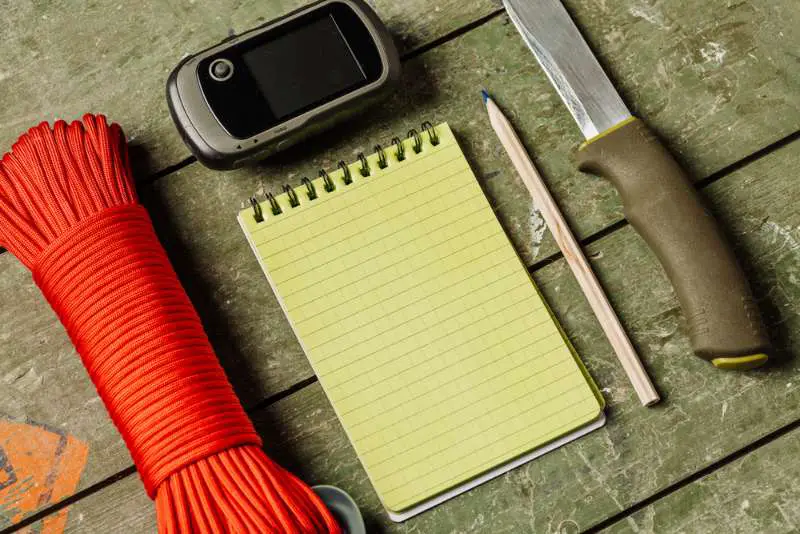
Geocaching is a minimal equipment type of hobby. You’ll need a phone, a pen, and a bottle of water to stay hydrated at the absolute least.
Seriously. That’s all you need. Or, you could create your own geocaching backpack like I did.
For a quick hunt, those three previously mentioned are all you need. But, if you decide you want to take your geocaching to the next level, you’ll want to get your kit together. A backpack is highly recommended, because it will hold all your equipment and free up your hands.
What should you take? Ultimately, it’s up to you. Here are some suggestions:
- Bug spray
- Sunscreen lotion
- Extra pens
- Snacks
- Cortizone
- Flashlights
- Plastic ponchos
- Umbrella
- Gloves
- Safety glasses
- First aid kit
A first aid kit is essential, along with gloves and safety glasses. From personal experience, I have witnessed another player poke their eye with a branch from a large bush that was hiding a cache. Their eye became infected and took a week to heal.
Cuts, scrapes, scratches happen from time to time. A few band aids and some neosporin will help a lot. Think of potential dangers when getting your kit together. It is better to have it and not need it, then to need it and not have it.
With safety out the way, think of what you might take with you if you were to go out hiking. Since you’ll be outdoors, everything that applies to hiking also applies to geocaching. At least to a lesser extent. Rather than preparing for a week-long hiking trip, instead pack for a day.
Another good reason for a backpack is it will hold plenty of water. Try to drink plenty of water while out exploring.
What do Geocaches look like?
You might be wondering what a cache looks like if you’ve never seen one before. The size typically determines what the container will be.
However, this is not always the case. Some players will be creative with their containers. It’s up to you to be hunting with a keen eye in order to find a cache.
One of the larger, and easier to find caches will be an ammo can. These large, metal boxes are what hold ammo, bullets, and have a lock to keep the contents secure.
You would be amazed at how well camo duct tape makes these near invisible out in the woods.
Speaking of camo duct tape, most caches hidden in woods, or in trees to be exact, will usually have this tape covering them.
Scaling down you’ll come across locking tupperware containers. Again, camo duct tape works wonders on these, along with black spray paint.
Another common container is pill bottles, or similarly sized film roll canisters, that have been painted. They are usually painted to differentiate an actual pill bottle that has been thrown out. These repurposed containers make excellent caches because of their size and ability to hold a log inside dry.
Micro caches are usually two metal ends screwed together in the middle. They are small, somewhere in the one to two inch range. Good luck locating these.
These are the common types of caches. The creative caches are for those who think outside the box. There have been false water faucets on sides of buildings that contain caches – this should give you an idea of how creative people get.
I highly invite you to check this list of possible geocaching finds! I include 10 possible interesting finds.
Looking for a Geocache (Tips)
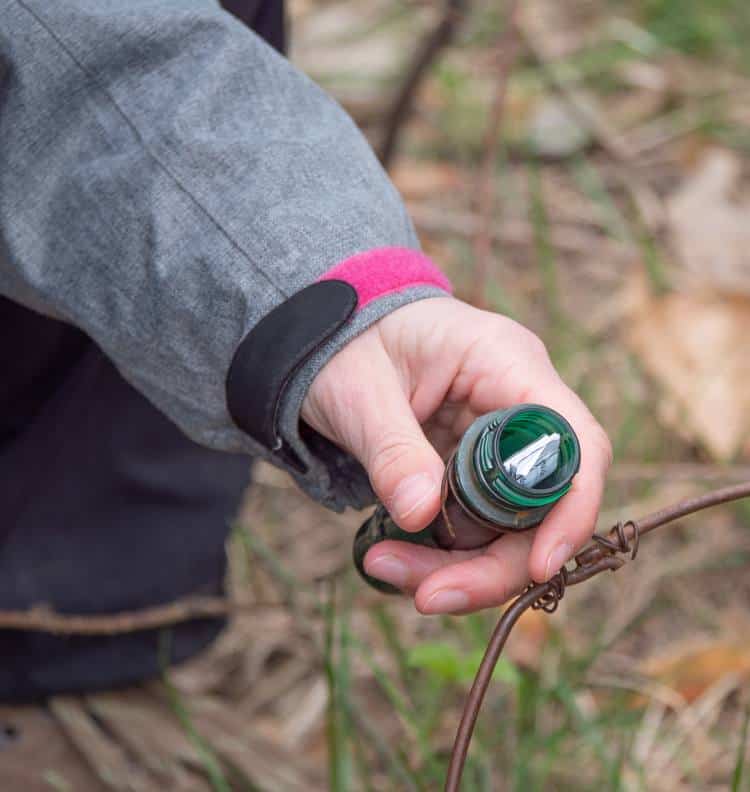
Hunting for a cache can be fun and exhilarating. Imagine trekking through the woods when suddenly something catches your eye.
At first it looks like it might be trash that someone left behind, but something about it sticks out to you. Could be where it’s placed, or the fact that it’s a peanut butter jar wrapped in camouflage duct tape. Either way, you found your treasure.
The best tip is to stay alert.
Something you’ll learn from experience is the limited accuracy you’ll receive after putting in GPS coordinates. This is something no one tells you. Then, when you factor in trees or other obstructions, accuracy decreases.
Which is why you should always be looking for places where you would hide a cache. More often than not, your ideas will match others.
Look deep within bushes, in holes around trees, underneath benches.
Everywhere could be a potential hiding place. The goal is to get close enough with GPS, then get creative on where you might hide a cache. You’ll find them out there.
Another great tip is to bring an extra pen. You may lose one or run out of ink. These two instances occur more often than you think.
One last tip when out looking for caches is to try your best to avoid muggles. The less muggles that know, the less likely it is for them to disturb a cache. It will be difficult, but it definitely adds to the fun.
Hiding a Geocache (Tips)
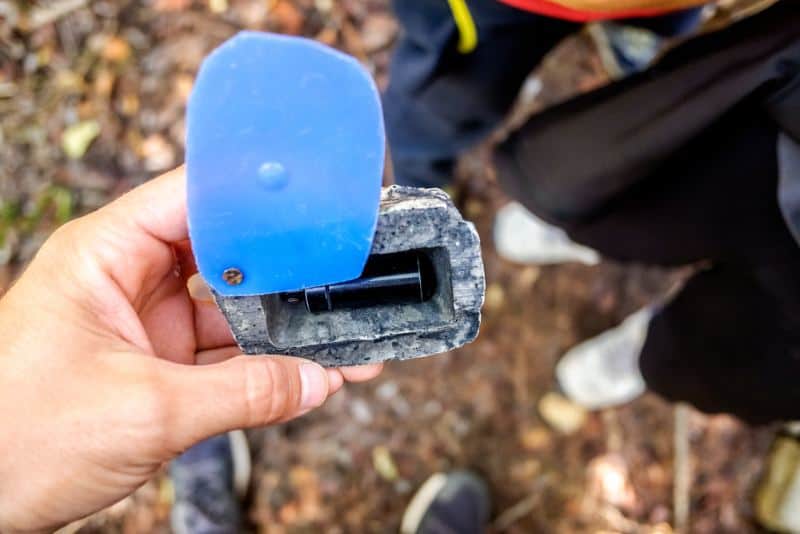
Maybe you don’t want to hunt, or want to try something new. Hiding caches could be as much fun as finding them. Your goal is to hide them well enough for a challenge, but not too well no one finds them.
First, decide what size you want to hide. A pill bottle is an excellent choice.
Be sure to paint, or wrap your cache in camo duct tape, then find somewhere near your home to hide it. Having the cache close to your home will make it easier to maintain it.
From here, you’ll have to register your cache on the official site. There are guidelines provided on the site and you should follow them closely or your cache will be denied. You will need accurate coordinates for a volunteer to inspect your cache.
Once they have determined your cache ready to go live, this process can take up to a week or longer in some cases, your cache will become public to everyone.
This is a simplified version of hiding a cache. Certain guidelines you’ll want to follow are the distance between yours and another and whether your hiding spot is of value to hunters. A dark alley in the middle of nowhere is not a wise choice versus a public park.
Additionally, geocaching volunteers will also provide tips and other useful information regarding your cache. Use their advice to your advantage.
Logging your find
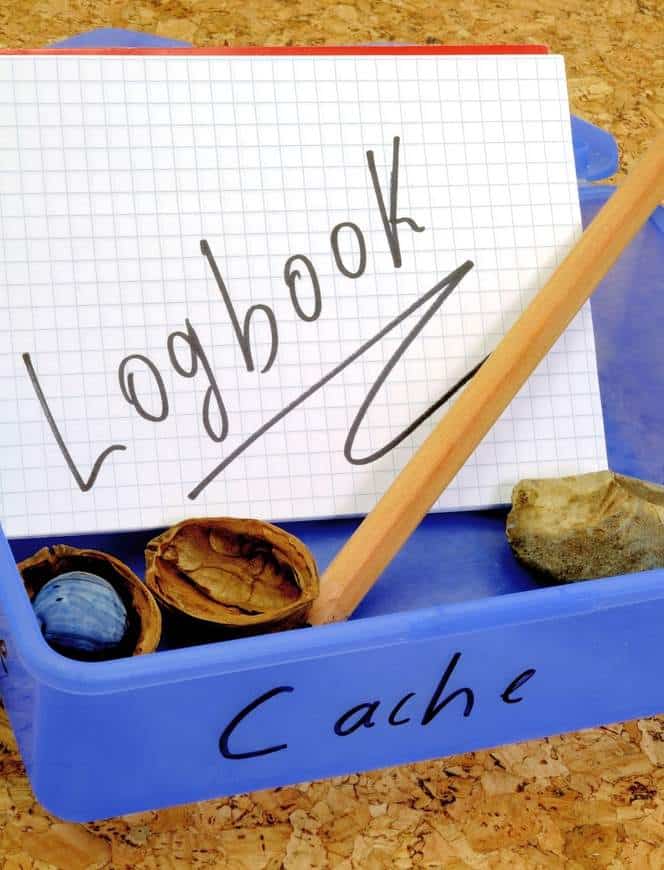
Why would you want to log your find? Well, for one it helps you keep track of all your finds, especially once you start getting into the hundreds! It’s definitely a lot to remember. Logging your finds helps you remember which ones you found, or in some cases didn’t find.
You can log caches you didn’t find, so in the future you can go back and give them another try.
Beyond traditional caches, there are 19 other types of caches. For example, puzzle, more mystery, cache involves solving problems to move on to the next set of coordinates. You will have to log your finds in order to progress.
Multi-caches are similar in which they involve two or more locations. Again, you’ll have to log your progress.
On the other end, those that hide caches will appreciate logs that contain important information, such as missing logbooks. Owners can read through the logs and determine whether or not maintenance is required.
Owners maintain caches, hunters are able to find these up kept caches. It’s a win-win situation for all.
Not only will you benefit from keeping your finds organized, but the next player will be able to enjoy the caches as well. Kind of a pay it forward type of system. Plus, you get some serious bragging rights when you begin to log in the hundreds.
Submitting your find
Briefly we went over tips for hiding a cache. Let’s go a little deeper now.
When submitting your finds, always remember to keep the cache family friendly. You never want to add anything to your cache besides a logbook and a writing utensil. Never leave any type of literature, or something perceived as an agenda.
Any type of promotion will also be denied. You want to keep your cache as neutral as possible. The place the cache is hidden is equally important as the cache itself. You do not want the cache to take away from the location.
Places of interest, or special monuments often overlooked are perfect for caches. Geocaching is the perfect opportunity to explore new areas you would otherwise pass by.
Volunteers understand the value of placing a cache in an area of interest that does not disturb anything. Which is why burying a cache is never a good idea, or placing one near a business or home that might bother people.
When submitting your caches, keep these ideas in mind and the less likely you are to be rejected.
Apps recommendations for Better results!
The absolute best app is the official geocaching app. It provides all the tools you need to find a cache and log it. You can view logs on caches, all the attributes, and load the ones you did not find to back after.
It is constantly updated and as long as you have a decent connection, you will have no problems navigating the app.
However, there are alternatives.
For Android, c:geo is the best alternative. It is an open source, full-featured geocaching app. The app is close as you can get to the official app on Android.
You can use the app offline, which means saving maps and cache logs and syncing later once you have a connection. It features the ability to create custom local lists in order to find only the caches you are interested in and avoids the ones you don’t want to find.
There are plenty of filters (like by difficulty, keyword, distance, terrain, longitude and latitude, etc.) that help narrow down exactly what you are looking for.
For iOS, Cachly is the best alternative. If you want to avoid the official apps annual subscription, you can instead choose Cachly for around $5. It is an official partner of geocaching.com, so those who are subscribers will unlock the full potential of Cachly.
Similar to c:geo, Cachly is full-featured with multiple filters, except this one offers a modern interface that is the easiest to navigate.
Mistakes to Avoid …
One of the biggest mistakes to avoid is not being aware of surroundings. It’s easy to get caught up in finding a cache. That does not mean you should just walk right up to where you think a cache might be. For all you know, there’s bees protecting their nest right above your treasure.
Or, there’s a loose dog on the run in the park. Maybe, a little bit of poison ivy is near the ammo can you’re staring at.
All these are perfect examples of real world dangers that occur while geocaching.
Notice how they all are easily avoidable by simply looking around.
Another mistake is overthinking. Sometimes a cache is in the most obvious place, such as in the hole in the tree where a branch splits off. Take a step back and take the whole scenery in.
Lastly, don’t forget about where you are looking. Why did the person hide the cache in this park? Maybe they took you to a graveyard. What is it about the headstone hiding cache you should notice?
You are exploring a new area, you should at least notice it.
Approaching Levels of difficulties
Each cache is assigned a difficulty and terrain level. These attributes are highly important information you should consider. The difficulty level usually corresponds with the size of the cache. A micro would be a high level difficulty, whereas an ammo can be much lower.
We have not talked about terrain, and now is a good time to bring it up.
Terrain is going to tell you whether or not you will have a stroll in the park or hiking up a mountain. Seriously, terrain is vital information you need to consider. If you are not fit for an uphill hike, maybe stick to easier terrain.
Combine these two attributes and you will get a feel for your adventure.
One of the more difficult caches would be a micro involving tree climbing. A large ammo can spray painted white requiring snowshoes will be even more difficult.
You get the idea.
The purpose of assigning these attributes is for those looking for a serious challenge will have an easier time determining whether they are up for one. Plus, terrain dictates what you will need, like snowshoes.
Consider your terrain and dress appropriately, and remember your difficulty level since it will give you a clue as to what to look for.
Geocaching code of ethics
Finally, follow the geocaching code of ethics. This code is simply known as The Geocacher’s Code. Here’s the code:
When placing or seeking geocaches, I will:
- Not endanger myself or others.
- Observe all laws and rules of the area.
- Respect property rights and seek permission where appropriate.
- Avoid causing disruptions or public alarm.
- Minimize my and other’s impact on the environment.
- Be considerate of others.
- Protect the integrity of the gamepiece.
For more information, you can learn more about Geocaching code of Conduct.
How important is this code? Extremely.
It sums up the idea of geocaching and what it means to be a geocacher. Go in undetected, do not disturb the environment, and get out unnoticed all while being respectful.
It’s simple, and respectful. This is the same way you should approach geocaching. Common sense plays a huge role in the game. If it is unsafe, avoid the area.
If you think you shouldn’t be somewhere, don’t be there.
Will you disturb others while hunting? Don’t hunt in that area.
By evaluating the situation logically and respectfully you’ll enjoy the hobby and rack up plenty of finds in no time.
Final Thoughts …
Hope this article was not too overwhelming for you since it is quite long and has quite a bit of potentially new information for you …
… But, don’t worry that much, Geocaching is an easy to learn hobby and everything will start making sense sooner than what you think.
Finally, if you have kids and want to introduce them to this activity, then I highly invite you to check this Geocaching guide for Kids!

